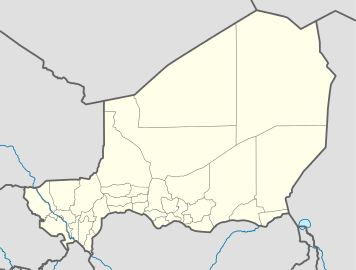Takedda
| Azelik | |
|---|---|
 Azelik Location of Azelik | |
| Coordinates: 17°31′6″N 6°46′59″E / 17.51833°N 6.78306°ECoordinates: 17°31′6″N 6°46′59″E / 17.51833°N 6.78306°E | |
| Country | Niger |
| Region | Agadez |
| Department | Tchirozérine |
Takedda was a town and former kingdom located in the present-day Western Sahara in Niger. The archaeological site at Azelik wan Birni is believed to be the ruins of ancient Takedda.
History
Takedda was founded by the Sanhaja, a Berber tribal confederation inhabiting the Maghreb. In 1285, a court slave freed by Mari Djata, the founder of the Mali Empire, who had also served as a general, usurped the throne of the Mali Empire. In the 14th century (possibly also earlier and later) the Tuareg-controlled kingdom of Takedda, west of the Aïr Massif, played a prominent role in long-distance trade, notably owing to the importance of its copper mines. Takedda was visited by Ibn Battuta on his return trip from the Mali Empire in 1353.[1][2]
Evidence of copperworking have been found at the site dating to the first millennium BC. The French archeologist, Danilo Grébénart, has excavated the site and has studied the significance of this prehistoric non-ferrous metal industry.[3]
The reign of Mansa Sakoura (also spelt Sakura) appears to have been beneficial despite the political shake-up. He added the first conquests to Mali since the reign of Ouali including the former Wagadou provinces of Tekrour and Diara. His conquests did not stop at the boundaries of Wagadou however. He campaigned into Senegal and conquered the Wolof province of Dyolof then took the army east to subjugate the copper producing area of Takedda.
Notes
- ↑ Dunn 2005, p. 305.
- ↑ Levtzion & Hopkins 2000, pp. 301-303.
- ↑ Grébénart, Danilo (1993), "Azelik Takedda et le cuivre médiéval dans la région d'Agadez", Le Saharien (Paris), 125 (2): 28–33.
References
- Dunn, Ross E. (2005), The Adventures of Ibn Battuta, University of California Press, ISBN 0-520-24385-4. First published in 1986, ISBN 0-520-05771-6.
- Levtzion, Nehemia; Hopkins, John F.P., eds. (2000) [1981], Corpus of Early Arabic Sources for West Africa, New York: Marcus Weiner Press, ISBN 1-55876-241-8. Pages 279-304 contain Ibn Battuta's account of his visit to West Africa.
Further reading
- Bernus, Suzanne; Gouletquer, Pierre (1976), "Du cuivre au sel. Recherches ethno-archéologiques sur la région d'Azelik (campagnes 1973-1975)", Journal des Africanistes (in French), 46: 7–68, doi:10.3406/jafr.1976.1773.
- Bernus, Suzanne; Cressier, Patrice (1991), La région d'In Gall - Tegidda-n-Tesemt (Niger). Programme archéologique d'urgence 1977-1981. IV Azlik-Takadda et l'implantation sédentaire médiévale (in French), Niamey: Institut de recherches en sciences humaines. Étude Nigériennes 51, ISBN 2-85921-060-1.
- Levtzion, Nehemia (1973), Ancient Ghana and Mali, London: Methuen, ISBN 0-8419-0431-6.
- Lhote, Henri (1972), "Recherches sur Takedda, ville décrite par le voyageur arabe Ibn Battouta et située en Aïr", Bulletin de l'Institut Fondamental d'Afrique Noire, B (in French), 34 (3): 429–470.